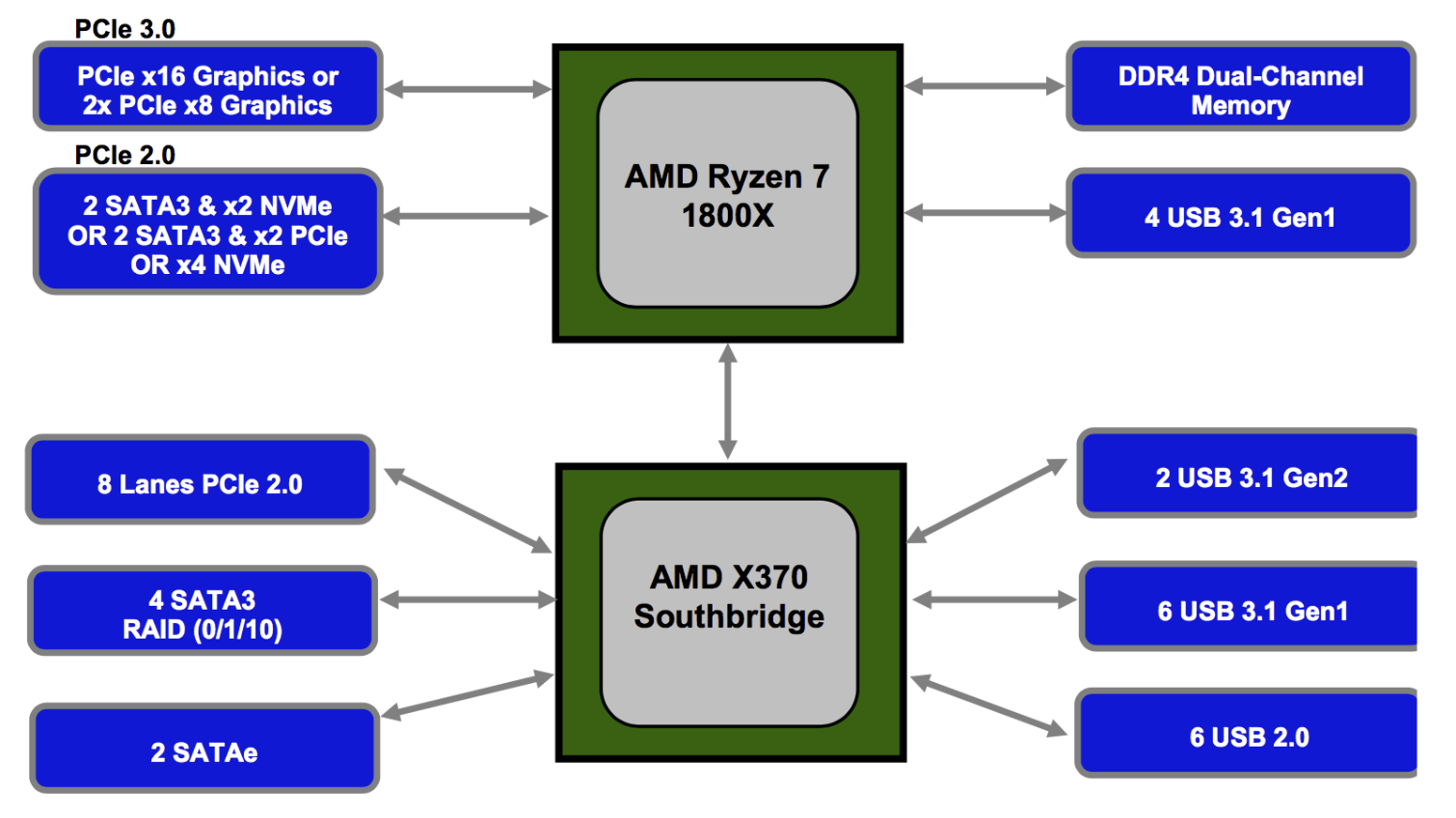AMD Ryzen 7 1800X CPU Review
Why you can trust Tom's Hardware
The AM4 Platform
AMD announced its AM4 interface and corresponding chipsets during the Bristol Ridge launch. Previously, core logic was a weak point, as the 9-series chipsets lacked a lot of modern features available from Intel's platforms. Moving forward, all Ryzen CPUs share the same socket. This gives you a number of options for building a Ryzen-, Bristol Ridge-, or future Zen+-based system.
Similar to Intel's platform controller hub architecture, AMD pushes integration with the move to Socket AM4 and tasks its chipset with functions typically associated with southbridges. Meanwhile, it adds more capabilities to the processor die you wouldn't expect to find there. For instance, Ryzen 7 1800X provides four USB 3.1 Gen 1 ports. It also offers 16 lanes of PCIe 3.0 we're guessing most enthusiasts will use for graphics, along with four lanes of second-gen PCIe for SATA 6Gb/s and NVMe storage. In time, we may even find board vendors building platforms based on just the CPU's I/O.
Intel's Core i7-6900K doesn't expose any USB connectivity directly. Rather, it relies on X99 and attached controllers to enable those ports. On the other hand, Broadwell-E packs up to 40 lanes of third-gen PCIe for a lot more flexibility in what you attach. Ryzen's ability to split its 16-lane PCIe 3.0 link into two x8 slots looks a lot more like Intel's mainstream chipset line-up in comparison.
AMD breaks Socket AM4 down into five different chipsets. Enthusiasts will want to pick up X370. B350 targets the mainstream crowd, whereas A320 goes the locked-down route for "essential" builds. For those of you who anticipate deploying APUs in HTPCs and LAN boxes, X300 and A/B300 should address those markets (we're still waiting on their specifications).
Given Tom's Hardware's focus on the enthusiast and mainstream markets, our motherboard reviews will emphasize X370 and B350. The two platforms are differentiated in much the same way AMD positioned the old 990FX and 970: a higher-end chipset gets you extra I/O, mostly. X370 includes four extra USB 3.1 Gen 1 ports, two additional SATA 6Gb/s ports, and two more second-gen PCIe lanes. Moreover, B350 doesn't allow you to split the 16-lane PCIe 3.0 link into two slots like X370 does.
Both Socket AM4 platforms support overclocking out of the box though, in addition to RAID 0/1/10 and two SATAe ports. AMD's documentation notes that SATAe ports can be broken up and re-purposed for additional SATA ports or second-gen PCIe lanes, potentially opening the door to larger storage arrays or additional M.2 ports.
According to AMD, the Socket AM4 interface will carry it through 2020. By then, technologies like DDR5 and fourth-gen PCIe should be prevalent, paving the way for newer platforms.
Get Tom's Hardware's best news and in-depth reviews, straight to your inbox.
Current page: The AM4 Platform
Prev Page AMD SenseMI Suite & XFR Next Page Overclocking & Test Setup
Paul Alcorn is the Editor-in-Chief for Tom's Hardware US. He also writes news and reviews on CPUs, storage, and enterprise hardware.
-
vrumor Well, at the very least, it is competition. Competition drives innovation and lower costs. Well done AMD.Reply -
kiniku Why did I feel AMD was hiding something? Understandably the "gamer market" is comparatively small. But couldn't AMD have designed a CPU that worked well in gaming/desktops and in data centers? Disappointing.Reply
(But I have a 5820K. The best Ryzen in the world would not have had me switch anyway.) -
xryanx123 Bias review as always. Most of your information is obviously screwed up. How do you get 4.0ghz at 1.45v. When that's not even an overclock for the chip (not really at least compared to stock) yet you're already pushing 1.45v? You're tailoring your articles for the uneducated. Duck off tomsReply -
captaincharisma in the end the best anyone can hope from AMD is that it spooked intel enough to lower its pricesReply -
ssdpro In a hurry to compare various site's gaming results, it appears differing sites are finding the same thing: gaming performance is acceptable but below 4c/8t Intel offerings. If you spend your day encoding or multi-thread benching this is a monster bargain.Reply
With the good and bad, I think we can all agree the good here is competition. There is some now. -
Pompompaihn All along AMD was claiming to equal/beat Broadwell-E in comparative tasks at half the price, and from another review that included Broadwell-E, it's done that. I don't recall ANY AMD press saying it was going to beat the 7700K in straight up gaming. So, target set, and hit. That's a win in my book. But now, need to see what they can do with the smaller core count chips and if they can scale frequency to be competitive in the gaming sector.Reply -
Dionisiatis Maybe i missed it but i would love to see a perf/dollar ratio comparison. Im sure Ryzen would occupy the top position, and it would also make it clear that AMD achieved extraordinary results in bringing such high performance to the average consumer that cant 700+ dollars for a CPU.Reply -
jackspeed @Dionisiatis the 7700K is cheaper then the 1800X so for gamers it currently is the best CPU. now games have yet to optimize for the new AMD architecture, so maybe soon it will be a different story.Reply -
Aspiring techie Your "Heating up AMD Ryzen" video on the Power and Temperatures tab is still private. I can't watch it.Reply -
Fails in gaming, and for multitasking stuff i got Xeon 14/28 who is doing all that encoding and other stuff for $300 on eBay.Reply
In my opinion AMD failed and they really pulled BS by fooling people into pre ordering but it turns out that in gaming sucks..
